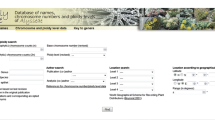Abstract
Karyomorphology ofCoriaria, the only genus of the family which is controversial with respect to its affinities and the number of constituting species, is investigated on the basis of ten species (including eight narrowly defined species) representing nearly all the variation of the genus. Features common to all the species investigated are: (1) interphase nucleus has a few small or large, condensed heterochromatic blocks; (2) chromosomes at metaphase are mostly small (0.4–0.7 μm long by our methods); (3)x=20. Resemblances in chromosome morphology suggest that Coriariaceae may have affinities with Rutales/Sapindales. Differences among species are found in (1) whether somatic chromosomes are diploid (2n=40) or tetraploid (2n=80); (2) the presence or absence of a few chromosomes with thick heterochromatic segments at metaphase; when such chromosomes are present, (3) their number and (4) morphology. Karyomorphology defines wellCoriaria myrtifolia, C. napalensis andC. japonica, and further provides evidence for distinguishing at least four species withinC. ruscifolia sensu Skog.
Similar content being viewed by others
References
Airy Shaw, H.K. 1973. J.C. Willis' A Dictionary of the Flowering Plants and Ferns. 8th edn. Cambridge University Press, Cambridge.
Allan, H.H. 1961. Flora of New Zealand. Vol. 1. R.E. Owen, Wellington.
Beuzenberg, E.J. andJ.B. Hair. 1983. Contributions to a chromosome atlas of the New Zealand flora—25 miscellaneous species. New Zealand J. Bot.21: 13–20.
Bohm, B.A. andR. Ornduff. 1981. Leaf flavonoids and ordinal affinities of Coriariaceae. Syst. Bot.6: 15–26.
Bowden, W.H. 1940. Diploidy, polyploidy, and winter hardiness relationships in the flowering plants. Amer. J. Bot.27: 357–371.
— 1945. A list of chromosome numbers in higher plants. I. Acanthaceae to Myrtaceae. Amer. J. Bot.32: 81–92.
Carlquist, S. 1985. Wood anatomy of Coriariaceae: phylogenetic and ecological implications. Syst. Bot.10: 174–183.
Cronquist, A. 1981. An Integrated System of Classification of Flowering Plants. Columbia University Press, New York.
— 1988. The Evolution and Classification of Flowering Plants. 2nd edn. The New York Botanical Garden, New York.
Dahlgren, R. 1983. General aspects of angiosperm evolution and macrosystematics. Nord. J. Bot.3: 119–149.
Garg, M. 1980. Pollen morphology and systematic position ofCoriaria. Phytomorphology30: 5–10.
Good, R. 1930. The geography of the genusCoriaria. New Phytol.29: 170–198.
Grimm, I. 1912. Entwicklungsgeschichtliche Untersuchungen anRhus undCoriaria. Flora104: 309–335.
Guerra, M.D.S. 1987. Cytogenetics of Rutaceae. IV. Structure and systematic significance of interphase nuclei. Cytologia52: 213–222.
Hemmer, W. andW. Morawetz. 1990. Karyological differentiation in Sapindaceae with special reference toSerjania andCardiospermum. Bot. Acta103: 372–383.
Hutchinson, J. 1973. The Families of Flowering Plants. 3rd edn. Clarendon, Oxford.
Khosla, P.K. 1978. Cytosystematics of some hardwood families. Nucleus21: 211–218.
Kyhos, D.W. 1967.In Documented chromosome number of plants. Madroño18: 245–246.
Mehra, P.N. 1976. Cytology of Himalayan hardwoods. Sree Saraswaty Press, Culcutta.
— andP.K. Khosla. 1969.In IOPB chromosome number reports XX. Taxon18: 213–221.
— andT.S. Sareen. 1969.In IOPB chromosome number reports XXII. Taxon18: 433–442.
Oginuma, K., P.H. Raven andH. Tobe. 1990. Karyomorphology and relationships of Celtidaceae and Ulmaceae (Urticales). Bot. Mag. Tokyo103: 113–131.
— andH. Tobe. 1991. Karyomorphology and evolution in some Hamamelidaceae and Platanaceae (Hamamelididae; Hamamelidales). Bot. Mag. Tokyo104: 115–135.
Okada, H. andM. Tamura. 1979. Karyomorphology and relationships on the Ranunculaceae. J. Jap. Bot.54: 65–77.
Praglowski, J. 1970. Coriariaceae. World Pollen Flora1: 15–22.
Scholz, H. 1964. Sapindales.In H. Melchior (ed.), A Engler's Syllabus der Pflanzenfamilien2: 277–288. Gebrüder Borntraeger, Berlin.
Sharma, V.K. 1968. Floral morphology, anatomy, and embryology ofCoriaria nepalensis Wall. with a discussion on the interrelationships of the family Coriariaceae. Phytomorphology18: 143–153.
Skog, L.E. 1972. The genusCoriaria (Coriariaceae) in the western Hemisphere. Rhodora74: 242–253.
Suzuki, M. andK. Yoda. 1986a. Comparative wood anatomy ofCoriaria of East Asia (1). J. Jap. Bot.61: 289–296.
— and -—. 1986b. Comparative wood anatomy ofCoriaria of East Asia (2). J. Jap. Bot.61: 333–342.
Takhtajan, A. 1986. Floristic Regions of the World. University of California Press, Berkeley.
Tanaka, R. andK. Oginuma. 1986. A method for the observation of chromosomes in woody plants.In Katauraet al. (eds.), Development of New Technology for Identification and Classification of Tree Crops and Ornamentals. Fruit Tree Research Station Reports (Ministry of Agriculture, Forestry and Fisheries), pp. 69–72. Maeda Print Co., Tsukuba.
Thorne, R.F. 1983. Proposed new realignments in the angiosperms. Nord. J. Bot.3: 85–117.
Author information
Authors and Affiliations
Rights and permissions
About this article
Cite this article
Oginuma, K., Nakata, M., Suzuki, M. et al. Karyomorphology ofCoriaria (Coriariaceae): Taxonomic implications. Bot. Mag. Tokyo 104, 297–308 (1991). https://doi.org/10.1007/BF02488383
Received:
Accepted:
Issue Date:
DOI: https://doi.org/10.1007/BF02488383




